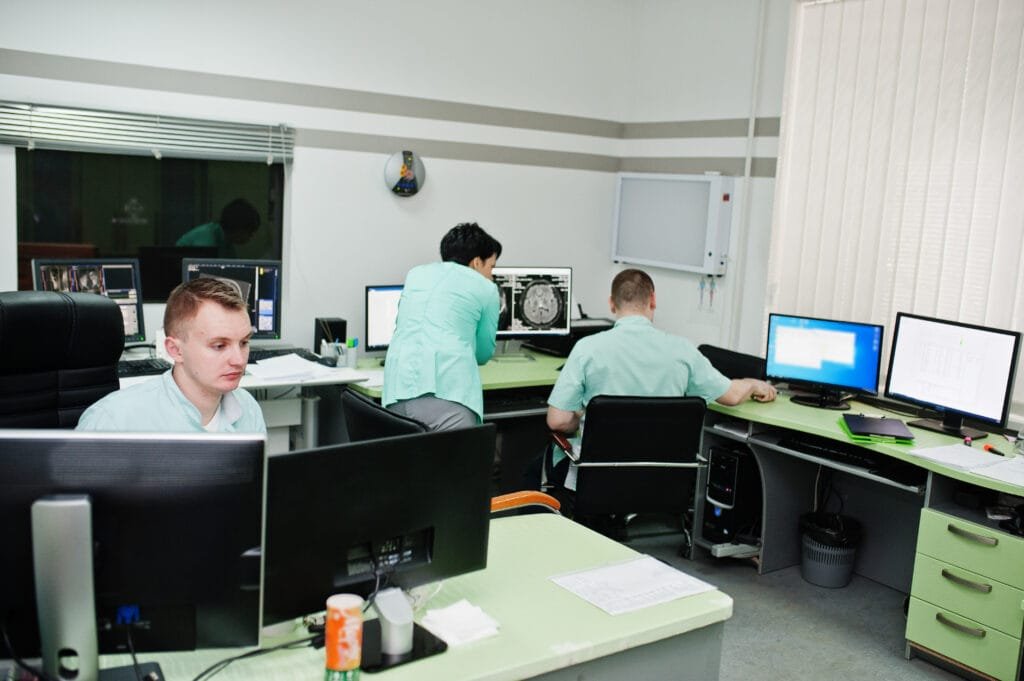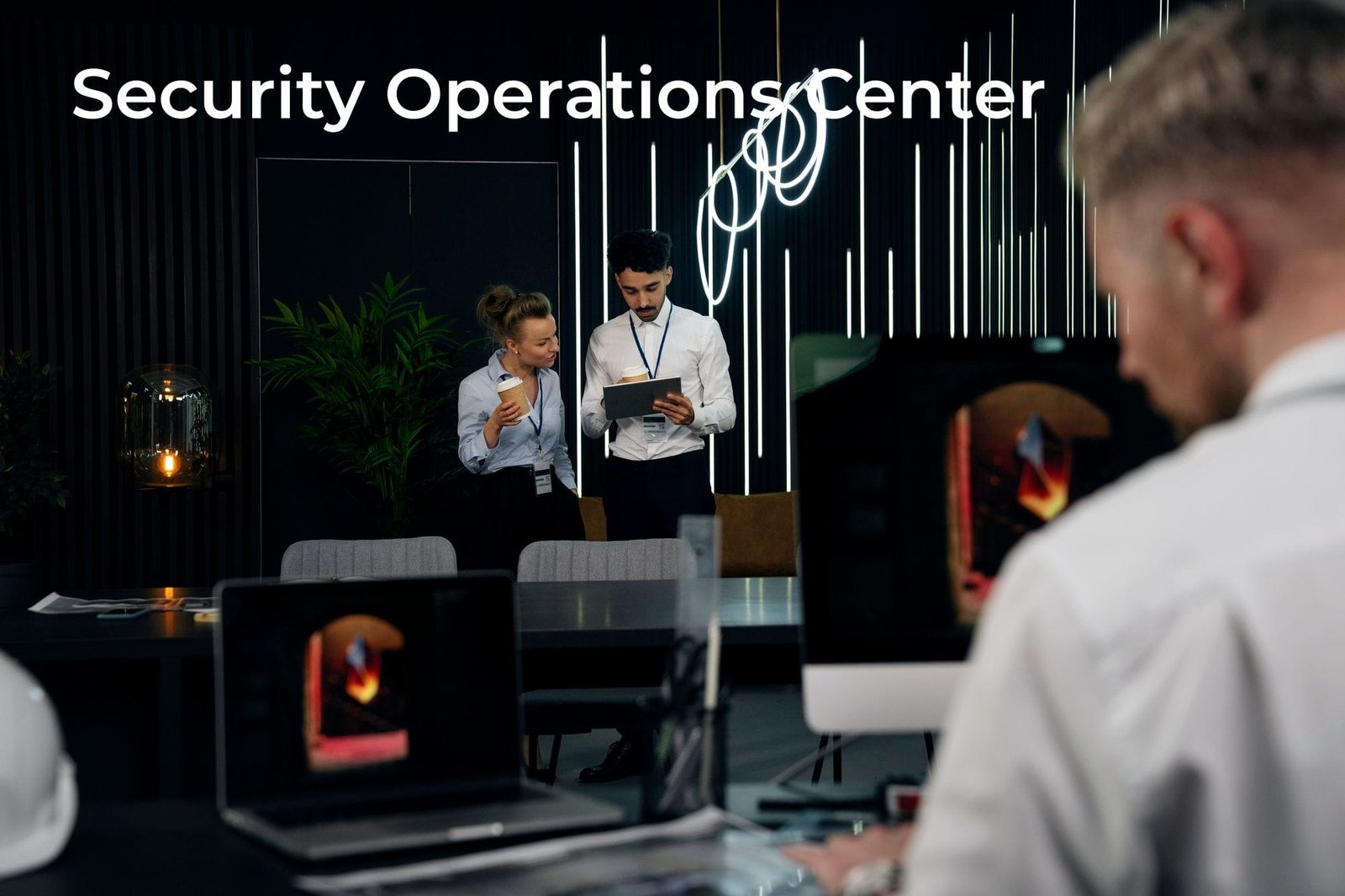Security Operations Center: Building, Operating, and Maintaining Your SOC
Security Operations Centers, or SOCs, are the hub of cybersecurity strategy and are essential for protecting companies from ever-changing threats. Careful design, skillful execution, and continuous enhancement are all necessary for creating, regulating, and maintaining an effective SOC. The complexities of setting up, maintaining, and growing a Security Operations Center are explored in this article to improve an organization’s security against cyber threats.
Introduction to Security Operations Centers (SOCs)
It is critical to understand the fundamental importance of SOCs in the current digital environment. As the first line of defense, these specialist units are always on the lookout for, identifying, and dealing with possible security incidents. An organization’s cybersecurity architecture revolves around a well-organized SOC, which plays a key role in coordinating the efforts of highly qualified staff, reliable processes, and state-of-the-art technology.
Key Components of a Security Operations Center
A Security Operations Center (SOC) is a complex system made up of essential parts that work together to ensure the cybersecurity resilience of an enterprise. Gaining an appreciation of these elements is essential to understanding the complex operations and efficiency of a SOC.
1. People
Professionals with expertise form the core of any SOC. These people have a variety of skills; they can be cybersecurity analysts who are skilled at identifying threats or event responders who can act quickly to prevent them. Usually, the SOC squad consists of:
- Security Analysts: Security analysts are in charge of keeping an eye on systems, analyzing security events, and addressing possible dangers.
- Incident Responders: Take prompt action to contain, look into, and fix security issues as they arise.
- Threat Intelligence Analysts: Compile, examine, and analyze threat information to proactively identify possible threats.
- SOC Managers: Organize activities, supervise the SOC, and make sure they are in line with corporate objectives.
An organization’s security posture improves when these positions work together since each member brings unique talents that are necessary for comprehensive threat management.
2. Processes
A SOC’s defined processes and procedures make up its operational framework. During security events, the team’s operations, incident response, and collaboration are guided by these protocols. Important procedures in a SOC consist of:
- Incident Response Plans: Detailed, step-by-step instructions describing the team’s expected timely and efficient reaction to security incidents.
- Threat Hunting Procedures: Proactive methods are used to look for possible weaknesses or threats in the infrastructure of the company.
- Escalation Paths: Hierarchical structures that establish the impact and severity-based hierarchy for occurrences.
These procedures optimize workflows, providing an integrated approach for managing security breaches and reducing reaction times.
3. Technology

Within a SOC, technology acts as a facilitator by offering the platforms and tools required to support cybersecurity initiatives. Among the essential technologies are:
- SIEM (Security Information and Event Management): Security Information and Event Management, or SIEM, gathers and examines security data from several sources to identify and neutralize possible attacks.
- Endpoint Detection and Response (EDR): This can provide fine-grained insight into device activity while tracking and reducing threats at the endpoint level.
- Threat Intelligence Platforms: collect and analyze threat information from several sources to anticipate and get ready for possible cyberattacks.
By combining these technologies, the SOC team is more equipped to identify, evaluate, and handle security events, improving the organization’s overall security stance.
Fundamentally, the core of a strong SOC is the collaboration of knowledgeable staff, clearly defined procedures and state-of-the-art technology. Every element is essential to improving an organization’s resistance to a constantly changing set of threats.
Building a Security Operations Center
An in-depth understanding of organizational objectives and security requirements, strategic implementation, and careful planning are necessary for the construction of a Security Operations Center (SOC). There are several crucial steps in building a SOC, all of which are necessary to produce a strong and reliable defense against cyberattacks.
1. Planning Phase
Before laying the groundwork for a SOC, it’s essential to define the objectives and scope. This phase involves:
- Identifying Security Goals: Determining the precise security requirements and coordinating them with the overall goals of the company.
- Assessing Risks: Identifying possible threats and weaknesses through a thorough risk assessment.
- Defining SOC Objectives: a list of the precise objectives the SOC hopes to accomplish, including risk mitigation, incident response, and threat detection.
2. Infrastructure Setup and Design
Once the goals and objectives are established, the next step involves setting up the physical and technological infrastructure:
- Infrastructure Requirements: Identifying the hardware, software, and networking components that are necessary to run the SOC.
- Designing the SOC Layout: arranging the physical layout, which includes server rooms, network connections, and monitoring stations.
- Integration of Tools: To speed up monitoring and incident response, security tools such as SIEM, EDR, and threat intelligence platforms are implemented.
3. Staffing Requirements
A crucial aspect of building a SOC is assembling a team with diverse skill sets and expertise:
- Defining Roles and Responsibilities: Clearly stating the positions, duties, and authority structures inside the SOC team.
- Recruitment and Training: Finding qualified individuals and giving them specific instruction in SOC operations and cybersecurity.
- Team Composition: Establishing a well-rounded team of analysts, responders, threat hunters, and managers to address various facets of security operations is known as team composition.
4. Documentation and Policies
Documenting procedures, protocols, and policies is essential for the smooth functioning of a SOC:
- Creating Standard Operating Procedures (SOPs): Developing comprehensive manuals for incident response, threat detection, and escalation protocols is known as Standard Operating protocols (SOP) creation.
- Establishing Policies: Establish guidelines for data management, access control, and compliance to ensure that legal requirements are followed.
- Communication Plans: Provide internal and external stakeholders with a list of channels and procedures for communication during security situations.
5. Testing and Validation
Before going live, rigorous testing and validation ensure the SOC’s readiness:
- Simulated Exercises: To evaluate the effectiveness of incident response plans and procedures, tabletop exercises and simulations are conducted.
- Validation of Tools and Processes: Check that security solutions are operating as intended and make sure they integrate seamlessly with the SOC architecture.
- Fine-tuning and Optimization: Increasing SOC readiness by making the required modifications in light of test results.
Creating a SOC is a methodical process that includes organizing, setting up infrastructure, forming teams, documenting, and validating. The basis for efficient security operations is established by a well-organized SOC, which empowers businesses to proactively defend against cyberattacks and protect their assets.
Operating a Security Operations Center

An organization’s cybersecurity resilience is largely dependent on the dynamic, day-to-day operations that take place within a Security Operations Center (SOC). To effectively reduce possible risks, running a SOC requires a combination of proactive monitoring, quick incident response, and efficient security event management.
1. Daily Operations and Workflow Management
The operational rhythm of a SOC revolves around continuous monitoring and analysis:
- Real-time Monitoring: Continuously keeping an eye on system logs, security alerts, and network activity to spot anomalies or possible threats.
- Incident Triage: Incident triage refers to the quick evaluation and categorization of security issues according to their impact and severity to prioritize response actions.
- Escalation Procedures: To ensure prompt resolution, problems should be escalated according to established criteria using well-defined protocols.
2. Incident Detection, Response, and Mitigation Strategies
The core function of a SOC is to swiftly detect, respond to, and mitigate security incidents:
- Threat Detection: Threat detection is the process of spotting possible dangers, anomalies, or suspicious activity by using advanced techniques and technology.
- Incident Response Protocols: Following established protocols for incident response to efficiently contain and remediate security breaches.
- Forensic Analysis: Investigating the incident in-depth to identify the underlying reason and stop it from happening again is known as forensic analysis.
3. Tools and Technologies for Effective SOC Operations
The efficacy of a SOC heavily relies on leveraging cutting-edge tools and technologies:
- SIEM (Security Information and Event Management): Security Information and Event Management, or SIEM, is the process of centrally managing and analyzing logs to correlate security events and spot trends.
- Automation and Orchestration: automating repetitive operations and coordinating actions to expedite the handling of incidents.
- Threat Intelligence Integration: Using threat intelligence streams to stay current on new threats and vulnerabilities is known as threat intelligence integration.
Keeping a SOC operational requires alertness, quick thinking, and a coordinated strategy for handling security events. The effective detection, response, and prevention of cybersecurity threats is enhanced when a company has a smooth operational process, competent individuals, and modern technology.
Maintaining a Security Operations Center
Beyond its initial setup and ongoing operations, a Security Operations Center (SOC) must be maintained. Maintaining the SOC’s resilience against changing cyber threats requires constant maintenance, improvement, and adaptability. The processes and strategies that are crucial for keeping a strong SOC are covered in detail in this section.
1. Continuous Monitoring and Improvement Strategies
Regular monitoring forms the cornerstone of SOC maintenance:
- Performance Monitoring: Performance monitoring is the process of keeping track of key performance indicators (KPIs) to evaluate how well the SOC detects incidents, responds to them, and reduces threats.
- Regular Audits and Assessments: Evaluate the SOC infrastructure regularly to find weaknesses, gaps, or areas that need improvement.
- Adherence to Best Practices: Ensure that cybersecurity activities adhere to industry standards and best practices.
2. Regular Updates, Upgrades, and Training
Keeping the SOC infrastructure and personnel updated is essential for staying ahead of threats:
- Infrastructure Updates: To fix vulnerabilities and improve defenses, frequent upgrades should be implemented for security tools, software, and systems.
- Technology Upgrades: Improving threat detection and response capabilities by assessing and implementing more recent technology.
- Continuous Training Programs: Giving SOC staff members regular training to keep them up to date on the newest techniques, skills, and information.
3. Addressing Challenges and Adapting to Evolving Threats
A proactive approach to challenges and emerging threats is critical for SOC maintenance:
- Challenges Mitigation: Using creative solutions and process optimization, challenges like alert fatigue, resource limitations, or talent problems are addressed.
- Threat Intelligence Integration: Integrating threat intelligence involves keeping updated on new threats, threat actors, and attack methods to proactively modify security measures.
- Flexibility and Agility: Cultivating an atmosphere that values adaptability and quickness to successfully respond to ever-changing threat environments.
The maintenance of a Security Operations Center necessitates a constant process of evaluation, enhancement, and modification. By adopting a proactive approach towards obstacles, remaining abreast of technical developments, and cultivating a culture of ongoing enhancement, establishments can maintain a resilient SOC that is capable of protecting against the always-changing terrain of threats.
Measuring the Success of a SOC

Assessing the effectiveness and efficiency of a Security Operations Center (SOC) is crucial for assessing its operational efficacy and optimizing cybersecurity resilience techniques. This section explores the important metrics, indicators, and assessment techniques that are necessary for evaluating a SOC’s success.
1. Key Performance Indicators (KPIs)
KPIs serve as benchmarks for assessing the SOC’s performance:
- Mean Time to Detect (MTTD): Calculates the typical amount of time needed to identify a security event as soon as it occurs.
- Mean Time to Respond (MTTR): Shows how long it typically takes to address and resolve security-related problems.
- False Positive Rate: Assesses how frequently false alarms are created, which affects operational effectiveness.
2. Threat Detection Rate
The rate at which the SOC identifies and mitigates threats is a critical metric:
- Threat Detection Efficiency: The percentage of threats that have been recognized relative to the total number of threats is known as threat detection efficiency.
- Incident Severity Analysis: Analyzing the severity of incidents found to determine the SOC’s capacity to manage high-risk circumstances is known as incident severity analysis.
3. Resolution and Containment
Efficiency in resolving and containing incidents reflects the SOC’s operational effectiveness:
- Incident Resolution Rate: The percentage of issues that are successfully resolved within a given period is known as the incident resolution rate.
- Containment Success: Assesses the SOC’s capacity to stop incidents from getting worse and keep them from getting worse.
Assessing a SOC’s performance entails a thorough examination of numerous metrics, KPIs, and qualitative indicators. Organizations can assess these factors to learn more about how effective the SOC is, pinpoint areas that need improvement, and put plans into action for improving their cybersecurity posture.
Challenges and Best Practices in Security Operations Centers (SOCs)
There are several difficulties involved in running a Security Operations Center (SOC), so putting best practices into practice is essential to overcoming these barriers. This section examines the typical problems that SOCs run into and provides best practices to maximize their performance.
1. Common Challenges
- Alert Fatigue: Analysts who get an excessive number of notifications may become so fatigued that they fail to recognize serious hazards.
- Staffing and Skill Shortage: SOCs face challenges in attracting and keeping highly qualified cybersecurity personnel.
- Adapting to New Threats: Upskilling and ongoing adaptation is necessary due to the rapidly increasing threats and sophisticated attack techniques.
- Integration Complexity: Difficulties in combining various technologies and security solutions into the SOC system.
- Regulatory Compliance: It might be difficult to meet compliance obligations while keeping operations running smoothly.
2. Best Practices
Automation and Orchestration: To reduce manual labor and prevent alert fatigue, automate regular chores and coordinate responses.
- Continuous Training and Skill Development: Putting money into continuing education initiatives to upskill current employees and draw in fresh talent.
- Threat Intelligence Integration: Using threat information streams to stay informed about new threats and proactively modify security measures is known as threat intelligence integration.
- Standardization of Processes: Creating uniform guidelines and practices to increase productivity and simplify workflows.
- Collaboration and Information Sharing: Promoting a culture of insight and information sharing within teams and promoting teamwork.
- Regular Assessments and Audits: To find gaps and ensure adherence to rules and best practices, regular evaluations and audits should be carried out.
3. Addressing Staffing Challenges
- Diverse Skill Sets: Building teams with a variety of skill sets to address various aspects of cybersecurity operations is known as “diversity of skill sets.”
- Training and Career Development: To keep qualified professionals on staff, offer chances for ongoing education and career growth.
- Outsourcing or Collaboration: To make up for a lack of skilled workers, partnerships or the outsourcing of specific tasks may be investigated.
It takes a proactive approach, a dedication to continuous improvement, and the application of best practices to successfully handle the issues faced by SOCs. Through the implementation of these methods, SOCs can improve their resilience, efficiently manage risks, and protect enterprises from constantly evolving cyber threats.
Future Trends in Security Operations Centers (SOCs)

Security Operations Centers (SOCs) must constantly adapt and incorporate new technologies since the cybersecurity landscape is always changing to keep ahead of increasingly sophisticated attackers. The predicted future trends influencing the development of SOCs are examined in this section.
1. AI and Machine Learning Integration
- Predictive Analytics: Predictive analytics refers to artificial intelligence (AI)–powered predictive models that use past data trends to anticipate possible dangers and facilitate proactive threat mitigation.
- Behavioral Analysis: Behavioral analysis is the process of identifying unknown risks and detecting unusual behaviors using machine learning techniques.
2. Automation and Orchestration Advancements
- SOAR (Security Orchestration, Automation, and Response): Better automation capabilities to expedite incident response and shorten reaction times are provided by SOAR (Security Orchestration, Automation, and Response).
- Integration with DevSecOps: continuous security throughout the development lifecycle with the smooth integration of security measures into the DevOps pipeline.
3. Zero Trust Architecture Implementation
- Micro-Segmentation: Reducing the attack surface and strengthening access controls by breaking up large network resources into smaller sections.
- Continuous Authentication: Using continuous user authentication in addition to more conventional perimeter security measures is known as continuous authentication.
4. Cloud-Centric Security Strategies
- Cloud-Native Security Tools: Customized security instruments made especially to counteract attacks originating from cloud settings.
- Secure Access Service Edge (SASE): SASE stands for Secure Access Solution Edge, which is a cloud-delivered solution that combines networking and security features to improve accessibility and security.
SOCs’ future is closely related to the upskilling of cybersecurity experts, the use of modern technologies, and the development of security plans. Adopting these trends will be essential to ensuring strong cybersecurity defenses for enterprises and improving SOCs against more complex cyberattacks.
Conclusion
For modern organizational security, creating, running, and maintaining a Security Operations Center is a complex task. The foundation of a strong cybersecurity posture is an organized SOC with knowledgeable staff, reliable procedures, and advanced technologies.
FAQs
How do I know if my organization needs a SOC?
Assess your organization’s risk profile and the sensitivity of the data you handle. If you deal with sensitive information or have experienced security incidents in the past, a SOC could be essential.
What tools are essential for an effective SOC?
Critical tools include SIEM (Security Information and Event Management), threat intelligence platforms, endpoint detection and response solutions, and incident response automation tools.
How often should SOC teams undergo training?
Regular training is crucial in the rapidly evolving cybersecurity landscape. SOC teams should ideally undergo training sessions quarterly or whenever there are significant changes in technology or threats.
What are the key performance indicators for measuring SOC effectiveness?
Mean Time to Detect (MTTD), Mean Time to Respond (MTTR), rate of false positives, and the number of incidents successfully mitigated are some essential KPIs for evaluating SOC effectiveness.
What are the common challenges faced by SOC teams?
Alert fatigue, staff shortages, retaining skilled analysts, and managing a vast amount of data are among the prevalent challenges that SOC teams encounter.
How can automation improve SOC operations?
Automation streamlines repetitive tasks, allowing analysts to focus on complex threats. It speeds up incident response, reduces human errors, and enhances overall SOC efficiency.







